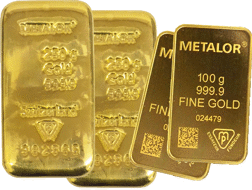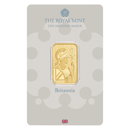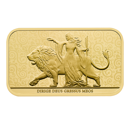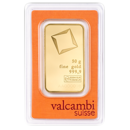How Much Does a Gold Bar Weigh?
In this modern age, gold bars have transformed from the unattainable status symbols of the past, to easily attainable assets offered in various weights and prices to suit almost any budget. In this article, we will explore the world of gold bars, revealing not only their characteristics, but also their value, and precious metal weight.
What is a gold bar?
Gold bars, also known as ingots, are refined forms of fine gold usually cast into standardised shapes for easy storage, transportation, and trade. In order to understand what constitutes a gold bar, it is helpful to be aware of the production process, as well as the history and characteristics that define a bar.
Production process:
- Mining: A gold bar begins its existence deep within the earth, where gold ore is extracted through mining. This ore is then transported to processing facilities to be refined.
- Refinement: After extraction, gold ore is refined to remove impurities and purify the metal. This process often involves techniques such as smelting, where the gold is melted down and separated from other metals, and chemical processes like electrolysis or cyanidation.
- Casting: Once the gold has been refined to the desired purity, it is cast into moulds to form the shape of a bar. These moulds come in various sizes and shapes, depending on the specifications of the gold bar being produced.
- Stamping and hallmarking: After casting, the gold bars are then stamped with markings including details of the weight, fineness, and manufacturer of the bar. These markings can serve as a guarantee of the bar's authenticity and quality.
Characteristics of gold bars:
- Purity: Gold bars are typically composed of highly pure gold, with most having a fineness of 999.9. This level of purity ensures that the bars retain their value and can be easily recognised and traded in global markets.
- Standardisation: The weights of gold bars are standardised in order to ensure easy trading and storage. Common weights for gold bars include 1 gram, 1 troy ounce (1oz), 100 grams, and larger denominations such as 1 kilogram.
- Dimensions: The dimensions of gold bars can vary depending on their weight and the manufacturer. However, in order to be easily handled and stacked, they often conform to similar dimensions.
Gold bars are available in two main types: stamped (minted) bars, and cast bars:
- Cast gold bars: Cast bars usually come in larger sizes and are more rugged in appearance. This type of bar is traditionally manufactured by pouring melted gold into a mould, with any markings applied manually using a press, guaranteeing the bar's authenticity.
- Stamped gold bars: Stamped bars, also known as minted bars, are usually manufactured by using a die to cut the shape from a large piece of gold. Usually available in smaller sizes, these bars can be identified by their smooth, even finish and are often supplied in a manufacturer’s assay card certifying their purity and authenticity.
Gold bars have a rich history dating back thousands of years, with evidence of their use as currency and symbols of wealth found in ancient civilisations such as Egypt, Mesopotamia, and Rome. Over time, gold bars have evolved from simple ingots used for trade to sophisticated financial products traded on global markets.
Today, gold bars are regarded as one of the safest and most reliable forms of investment, offering a tangible asset that can retain value over time. Whether held by individual collectors, or large institutions such as central banks, gold bars continue to play a large role in preserving future wealth and diversifying portfolios.
How is a gold bar weighed?
Weighing gold bars accurately is essential in order to determine their value. Various metrics of measurement are used to weigh gold bars, with the most common being troy ounces and grams.
- Troy ounces: The standard unit of measurement for precious metals, including gold, is the troy ounce. Unlike the avoirdupois ounce used in non-precious metal transactions, which equals approximately 28.35 grams, the troy ounce is slightly heavier, weighing about 31.10 grams.
When weighing gold, especially in the context of trading, troy ounces are a preferred unit of measurement due to their standardisation within the precious metals industry. Prices of gold are typically quoted per troy ounce in financial markets worldwide. - Grams: Grams are a commonly used unit for measuring the weight of gold bars, especially in countries that use the metric system. One troy ounce is equivalent to approximately 31.10 grams, providing a precise measurement for smaller quantities of gold.
- Kilograms, and pounds: While troy ounces and grams are the most commonly used units of measurement for gold bars, other units such as kilograms and pounds are also occasionally used, particularly in different regions.
In some instances, particularly when dealing with larger quantities of gold bars, kilograms may be used as the unit of measurement. One kilogram is equivalent to approximately 32.15 troy ounces. Although less common in gold bar trading, pounds may also be used as a unit of measurement in certain regions. One pound is equivalent to approximately 12 troy ounces.
How much does a bar of gold weigh?
Gold bars come in a wide range sizes and weights, from a tiny 1g, to a bulky 1kg and more, catering to the needs and budgets of different collectors.
Gold bars are produced with a high level of purity, usually at 999.9 fineness. This means that the gold content in the bar is 99.99% pure, with only tiny trace amounts of other metals present, ensuring the intrinsic value of the gold bar.
The value of a gold bar depends on its weight, fineness, and current market prices. Gold bars are valued based on the current spot price of gold, which constantly fluctuates according to arrange of factors such as supply and demand, economic conditions, and geopolitical factors.
Below is a comparison table showing the weights, dimensions, fineness, and approximate values of different sizes of gold bars. This table provides an overview of the various sizes of gold bars available, allowing collectors to clearly assess their options.
| Gold Bar Weight | Description | Typical Length* | Typical Width* | Typical Depth* | Fineness | Value** |
|---|---|---|---|---|---|---|
| 1kg Gold Bar | One Kilo | 117.00mm | 52.00mm | 9.00mm | 999.9 | £61,183.41 |
| 500g Gold Bar | Half Kilo | 86.00mm | 38.00mm | 8.50mm | 999.9 | £30,298.98 |
| 10oz Gold Bar | Ten Troy Ounces | 60.00mm | 35.00mm | 9.00mm | 999.9 | £19,334.47 |
| 250g Gold Bar | Quarter Kilo | 58.00mm | 35.00mm | 8.00mm | 999.9 | £15,546.68 |
| 100g Gold Bar | One Hundred Grams | 45.00mm | 25.00mm | 5.00mm | 999.9 | £6,121.63 |
| 50g Gold Bar | Fifty Grams | 47.00mm | 27.00mm | 2.40mm | 999.9 | £3,074.68 |
| 1oz Gold Bar | One Troy Ounce | 38.00mm | 22.00mm | 2.30mm | 999.9 | £1,920.54 |
| 20g Gold Bar | Twenty Grams | 31.00mm | 18.00mm | 2.20mm | 999.9 | £1,260.52 |
| 10g Gold Bar | Ten Grams | 25.00mm | 15.00mm | 1.60mm | 999.9 | £639.38 |
| 5g Gold Bar | Five Grams | 23.00mm | 14.00mm | 1.00mm | 999.9 | £329.50 |
| 2.5g Gold Bar | Two and a Half Grams | 19.00mm | 12.00mm | 0.80mm | 999.9 | £174.08 |
| 1g Gold Bar | One Gram | 15.00mm | 8.50mm | 0.55mm | 999.9 | £78.08 |
*Dimensions are approximate and may vary depending on the manufacturer and whether the product is a cast bar or a stamped bar.
**Value is approximate and is based on a current spot price of £1854.14 at the time of writing. Prices will change along with the fluctuating price of gold.
How do I buy or invest in a gold bar?
Many individuals choose to own gold bars in order to diversify their wealth and safeguard their assets. At Atkinsons, we make it easy to purchase high quality gold bars online, offering a wide range from the world’s most reputable mints and manufacturers, ensuring authenticity and quality.
Gold bars come in a variety of weights and shapes, so it is important to consider your budget, preferences, and goals when selecting the right gold bar for your needs. We provide options ranging from small 1 gram bars to larger 1-kilogram bars, each with its own attributes.
Once you have chosen your gold bar, you can simply place your order through our secure website or reach out to our client service team for assistance. We aim to make the purchasing process as straightforward and convenient as possible for our clients. Your gold bar will then be meticulously packaged and delivered to your address in discreet packaging using insured shipping to ensure the safe delivery of your gold.
It has never been easier to buy a gold bar and add this valuable asset to your portfolio. Our commitment to unparalleled service, quality, and fair prices ensures that your gold bar purchase with Atkinsons is a secure choice.
If you have any questions or require assistance with your purchase, our knowledgeable client service team are always ready to help. Please call us on 0121 355 0620 or email info@atkinsonsbullion.com today and begin your journey into the world of gold bar ownership with Atkinsons Bullion & Coins.
This blog represents one person’s opinion only. Please note, gold and silver prices may go down as well as up. Atkinsons Bullion & Coins accepts no responsibility for any losses based on information we have provided. We do not offer investment advice. Please carry out your own research before making an investment decision.















